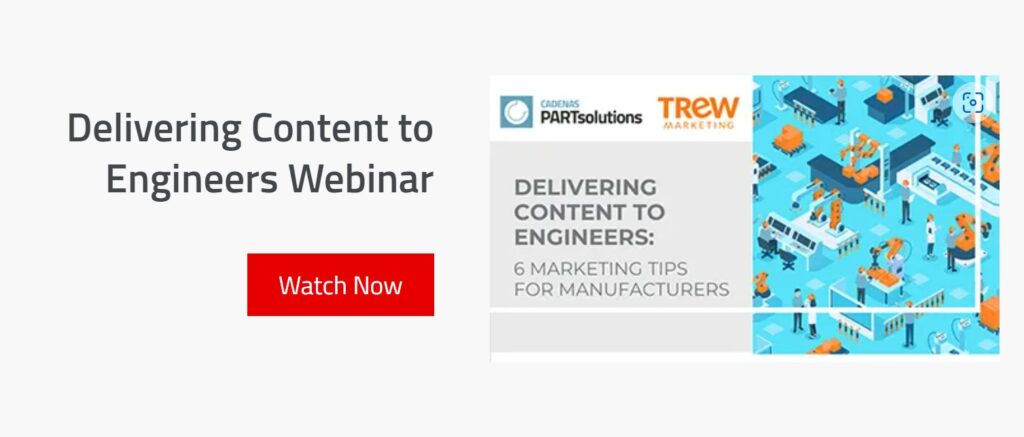
Industrial Marketing Content: How to Drive Sales by Delivering Product Data to Engineers & Architects
Adam Beck: Welcome everyone to the delivering industrial marketing content to engineers, webinar. This is Six Marketing Tips for Manufacturers. My name is Adam Beck. I am all about inbound content. I’ve been marketing for 20 years. I’ve worked in the past for manufacturers helping promote products. Now, I work for CADENAS PARTsolutions as the Director of Marketing, where we help manufacturers provide shareable industrial marketing content to their users.
Wendy Covey: Hey everyone. I’m Wendy Covey. I’m the CEO and co-founder of TREW Marketing. We help technical companies build trust and grow their business using content marketing.
A little bit about myself: I’ve been in the engineering space for over 20 years, all that time in marketing before founding TREW 13 years ago. I was part of the leadership team at National Instruments, now known as NI.
And I also published a book last year. It’s called Content Marketing Engineered, and I have a podcast by the same name. So glad you’re here today.

Analyzing two industrial marketing content surveys
Adam Beck: All right. I’m glad to have you here too. I’m excited to get going on this. Let’s get to the goals of this webinar. So, I’m super excited about this because I don’t think it’s ever been done before to where two surveys come together and discuss their results.
We’re going to get insights from the research about how engineers and architects seek information for their jobs. We’ll also identify ways to improve your industrial marketing content and online experience to attract, nurture, and convert technical buyers. So, let’s get into the surveys themselves.
At CADENAS PARTsolutions, we surveyed 128,000 PARTcommunity users. These are engineers and architects who recently opted in from our portals. We had several thousand who completed the survey, which gave us a great sample size to draw conclusions from.
Wendy Covey: That is a great sample size. And ours is very similar.
This marks the fourth consecutive year that Global Spec and TREW Marketing have partnered together to better understand how engineers and technical buyers seek and consume information to make purchase decisions. We had over 1300 engineers and technical buyers across the globe respond to our survey.
And the report is interesting because we’ve been doing this for several years now. We have findings that are reinforced year after year, and we also have findings that show generational trends and both of which all highlight as we walked through the research today.
So, our format today will be that Adam and I will walk through a portion of the research findings from each report, and then we’ll discuss those topics.
Let’s get started with our first research finding.
Okay, here we go.
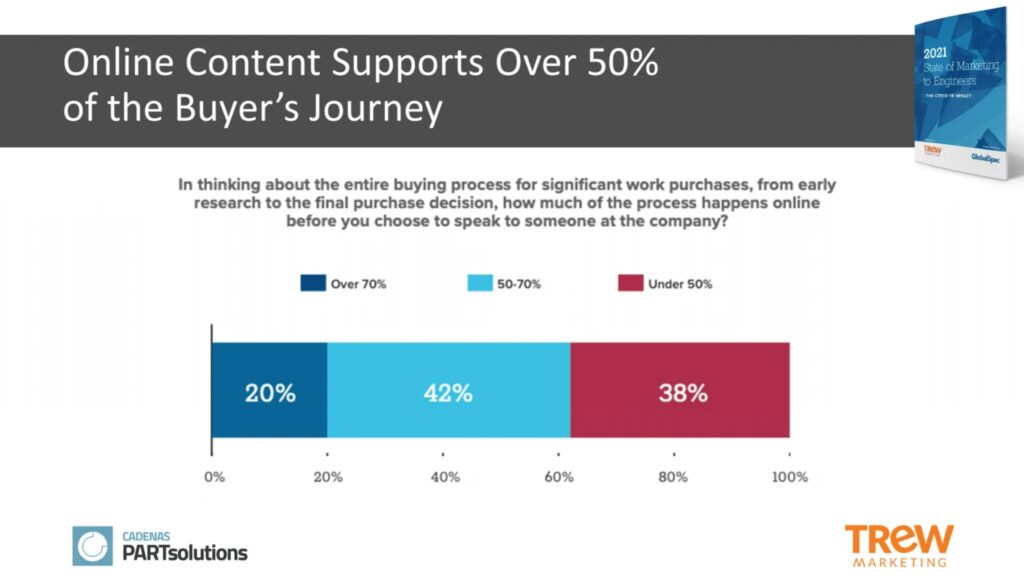
How much of the buying process for engineers happens online?
Wendy Covey: We asked, “in thinking about the entire buying process for a significant work purchase. How much of that process happens online before you choose to speak to someone at a company?”
So, the engineers and technical buyers, as you can see, have moved online to complete much of the buying process. Sixty-two percent of respondents completed more than half of the buying process online before they wanted to talk to sales. This is very similar to what we’ve seen in previous years. Time spent online is even greater for younger engineers who are digital natives.
Adam Beck: Yeah, this is a perfect lead-in for the rest of the findings because it’s something manufacturers really need to think about.
We assume online shopping as only for B2C or retail products where something is actually being purchased directly, but it applies to anyone selling anything nowadays. Manufacturers need to ask themselves, are they currently providing the data and tools their audience needs to research and make those buying decisions.
If following up on downloads, ensure your message is relevant
Wendy Covey: Yeah. And in addition, I think this highlights not only having a strong online presence, but also companies should keep in mind that engineers are not ready to talk to a salesperson early in their journey. And so I know, Adam, you’ve been to sites where people immediately pushed for that sales engagement.
Maybe they have that contact us form right on their homepage, for instance, Or maybe a sales team calls them once a technical buyer fills out that very first form, and that’s just too soon. And those companies aren’t in sync with these buyer preferences that want to self-educate first.
So definitely…
Adam Beck: If we’re gonna follow up. They need to make sure that yeah. Make sure that the message is right if they’re going to do that right off the bat.
Wendy Covey: Yeah, no doubt. No doubt.
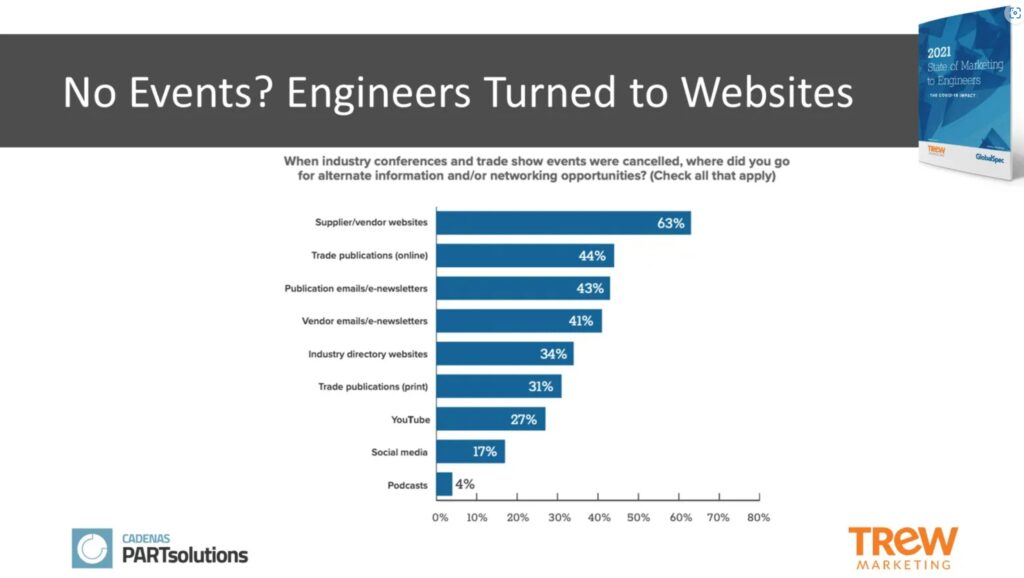
When they can’t attend events, where do engineers turn for information and industrial marketing content?
Wendy Covey: So speaking of online behavior, let’s look at what happened when COVID caused a hole to travel and face-to-face events.
We asked, “when industry conferences and trade shows are canceled, where did you go for information and networking opportunities?”
And as you can see here, during the COVID shutdown, engineers turned to their tried and true channels, supplier websites, industry trade websites, and e-newsletters have long been popular channels for engineers to turn to when seeking information.
However, in the wake of cancellations, an increased number of engineers turned to trade publications. This might’ve been because these publications were often also responsible for those in-person events, and engineers were looking for the same news. They would typically have gathered during those in-person events like trade shows.
Newsletters are still an important strategy for delivering industrial marketing content
Wendy Covey: I also want to point out the finding on e-newsletters this remains a consistent, valued source for information and in another research question, which we’re not gonna go into depth today. We dug in further on the newsletters and found that a whopping ninety-two percent of engineers subscribed to at least one newsletter out of those, 43% are likely to subscribe to three to five. And one-fifth of the respondents said they subscribed to six or more e-newsletters, and then when you break this out by age, it’s really interesting. So the gen X-ers like me and above are more likely to just subscribe to six or more newsletters. So we like our email, whereas younger counterparts are half that they want to look at half as many newsletters.
Adam Beck: Is it weird that I want to jump up and cheer every time I hear gen x?
Wendy Covey: Not at all, not at all.
Provide engineers resources online
Adam Beck: To me, it’s line one that jumps out and adds emphasis to the previous findings. We do in-person events to meet and greet and build those relationships, but you don’t have that. So it’s moved online, and it’s happening on the vendor website.
So is the content they need available to learn and discover and select the correct product is what the audience needs. We saw this last year in our stats. Our portal downloads from all of our manufacturers jumped forty-five percent year-over-year to more than 660 million downloads. That’s engineers…
Wendy Covey: That’s a huge jump, Adam.
Adam Beck: Yeah. And that’s engineers and architects all going out to research products, select content to put into their designs.
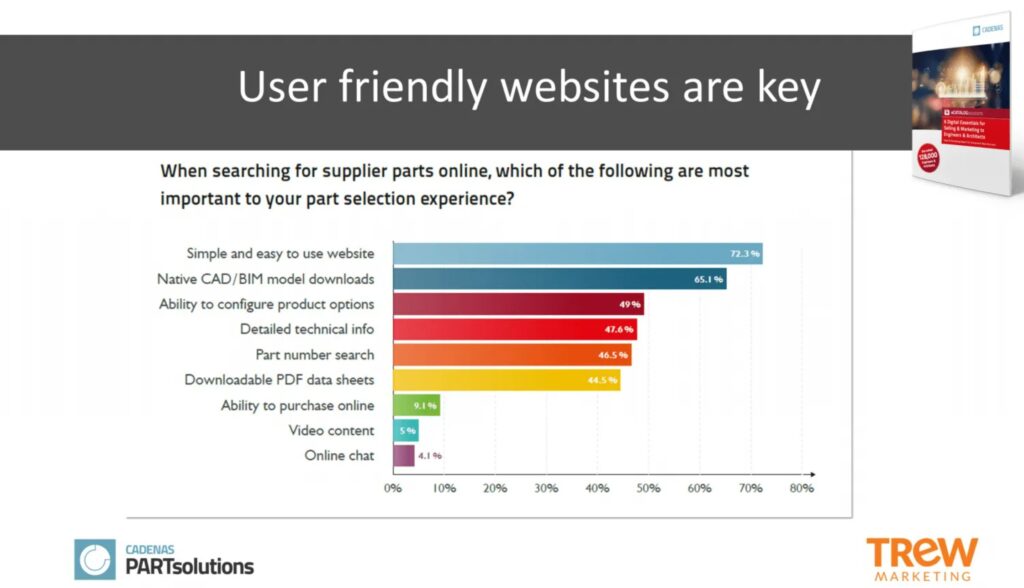
User experience shouldn’t be taken lightly
Adam Beck: So, let’s get to the next one. We asked, “when searching for supplier parts online, which of the following are most important to your selection experience?”
The most important factor for engineers and architects was they want, seventy-two percent wanted, a simple and easy-to-use website, with native and CAD and BIM downloads following closely behind it 65%. This is telling me the engineers and architects want to get in, navigate a manufacturer’s website quickly, get the data they need, and get back to work.
Wendy Covey: It’s very telling that simple and easy was the number one response. And it indicates to me how many websites out there still have a poor user experience.
And it’s tempting for we marketers to jump in and want to add bells and whistles to our websites, such as product configurators and online chat. But this research tells me that usability provides the biggest payoff. And until you have that nailed, you should move on to these other features.
Adam Beck: Yeah, just make it easy, make everything easy. A great thing to do is to have someone that’s not at your company test your site, navigate around and tell you if they can figure it out, or if they’re confused, that’s a great indicator that you might have something to fix.
Wendy Covey: Oh, exactly. Too often, companies use their own terminology, especially in their navigation. So, I think like product names or acronyms, heaven forbid, and they’re not thinking from a user’s point of view. So it’s important to identify your target personas, construct your navigation and user paths towards those audience groups and then test with real actual customers and target individuals, not just your internal staff.
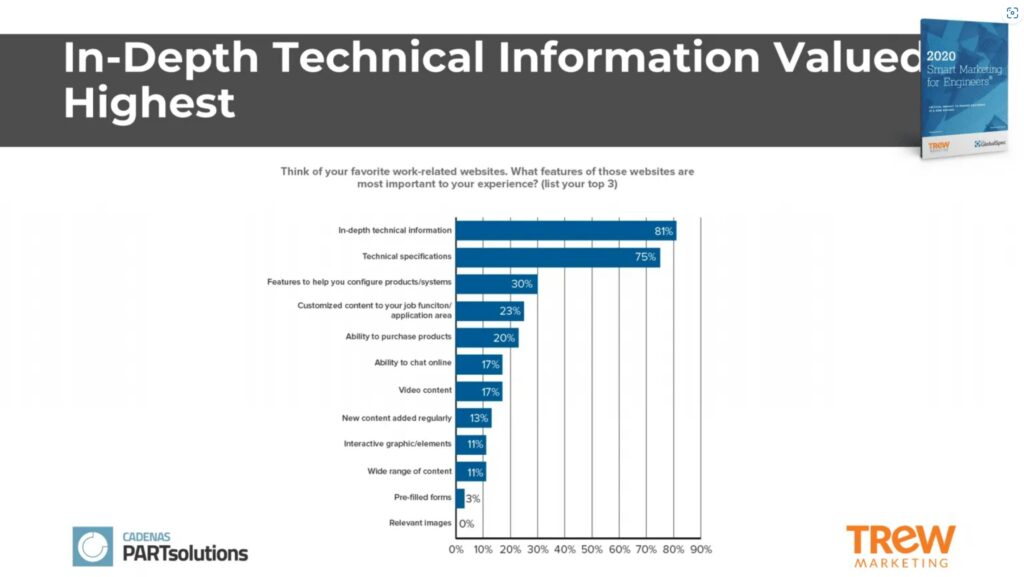
What features are important in work-related websites?
Wendy Covey: Adam, my 2020 research report also asked a similar question about web experiences. Let’s take a look.
We asked, “think of your favorite work-related websites; what features are most important to your experience?”
So, here we have a different set of response options focused on various industrial marketing content and various features that a website might have; we mix them in together. And again, similar responses in-depth, technical content, and specs blew away the other web features, with product configurators at a distant third. Only 20% of respondents ranked e-commerce in their top three. So, if you’re weighing web investment for 2021, you might want to allocate your budget towards technical content and usability rather than a costly e-commerce project.
Adam Beck: Yeah, it’s interesting to me how different the questions are structured, but the responses are so similar when you step back and see what they’re saying. It’s all about available industrial marketing content, the detail, the accuracy of the information, helping them get what they need and get back to work.
Wendy Covey: Yeah, exactly. Companies that are generous with technical content are more likely to convert buyers. That’s what this data’s saying.
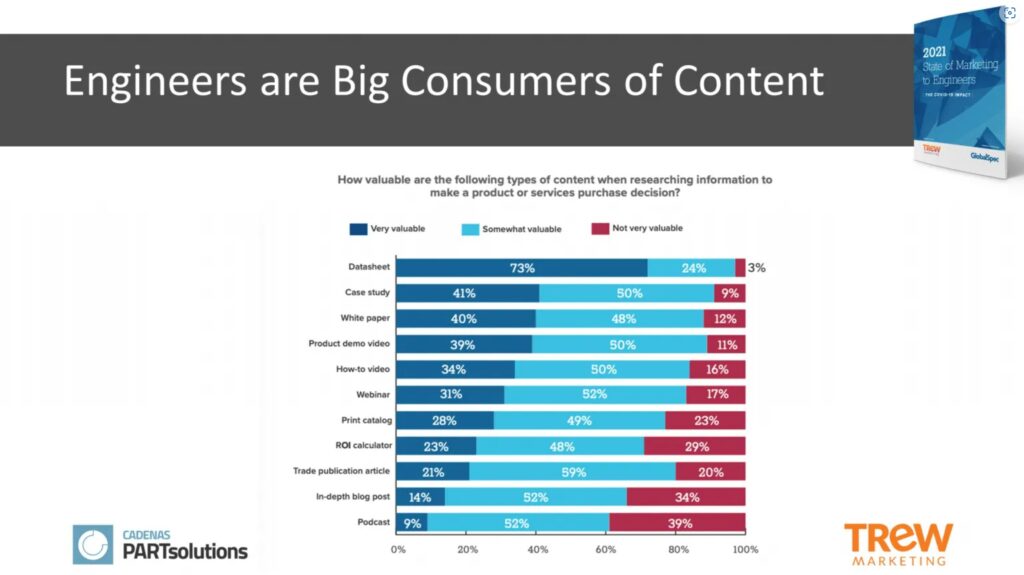
What types of industrial marketing content are most relevant for engineers
Wendy Covey: So speaking of technical industrial marketing content, I’m often asked what types of content should I be creating for my technical company? Let’s take a look at that finding.
We asked, “how valuable are the following pieces of content when researching information to make a purchase decision.”
And what I want you to look at is the dark blue bar and the light blue bar. These are very valued or somewhat valuable. And you see here that engineers in technical buyers are hungry for information, and they consume content in a variety of forms, datasheets, case studies, white papers, and product demo videos top the list is the most valuable content types for this audience. This is very much aligned with our previous year’s findings.
Then when you look at the red, that’s the not very valuable category. You’ll see that there’s not a lot of red.
So, podcasts are the least valued of the industrial marketing content types. But in another research question, we asked, “do you listen to podcasts for work?” And 50% of technical buyers said that, yes, they listened to at least one podcast for 30 minutes weekly for work. And, I think this will be a growing channel in one to keep an eye on over the years.
PDF datasheets add value to engineers
Adam Beck: Yeah, definitely it’s line one that catches my eye because it reveals a small secret we don’t talk about very often. That PDF data sheets tend to be the most popular format downloaded from many of our manufacturers. And it might seem counterintuitive, but it’s that one universal format that everyone uses.
All of the individual CAD formats are super important for their verticals and their industries, but they’re all fighting for market share. The PDF is the one universal format that everyone uses. So, these need to be available, accurate, and full of detail. My other takeaway is how low the print catalog is on there.
That’s probably the most expensive and the most time-consuming item on the list. I’ve spent many months creating those in my past lives, and I don’t miss it one bit.
Wendy Covey: Oh, no. The ROI is so low in those print catalogs. I was sad that it ranked as high as it did. Definitely, not a good use of budget. But I agree the PDF datasheets are not sexy, but clearly, from this data, they’re critical.
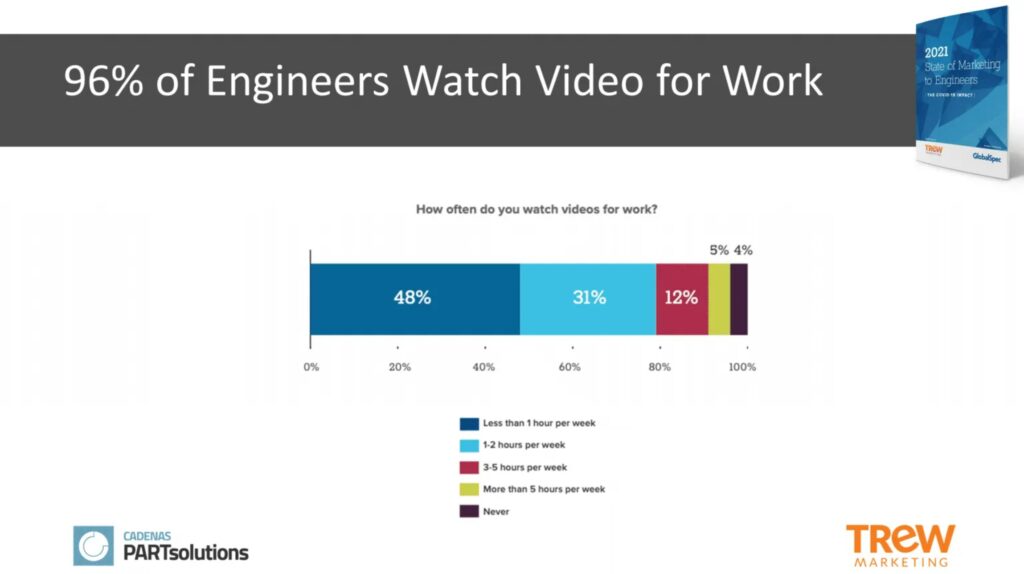
Videos and webinars are excellent industrial marketing content delivery tools
Wendy Covey: The other thing that I like about this slide is I like looking at videos and webinars. They’re very closely ranked here. And I think there’s a lot of overlap in how these formats are consumed. When you think about the on-demand webinar versus the video, it’s a gray area where one bleeds into the other. And based on what I’m seeing so far in 2021, at TREW Marketing, I just declared it. This is the year for webinars. So, this is the year of the webinar, like the year of the dog or whatever it is this year.
Attendance has been up dramatically at our client’s webinars at our own webinars. And I’m sure some of this is in part to industry events not happening face-to-face, and so it’ll be interesting to see how things progress as the world opens back up and people start traveling. We still see this big spike in webinar attendance, and I tend to think they’re here to stay. They’ve long been a great source. Anyway, we’ll see, but for 2021 go forth and conquer those webinars.
Now, while I’m on the subject of webinars and video, let’s take a deeper dive into video itself and see what these technical buyers had to say.
We asked, “how often do you watch videos for work?”
A whopping ninety-six percent of engineers watch some videos for work, and this is up for 93% from the previous year. That’s almost everyone, right.
Adam Beck: Yeah. Am I reading that correctly? That forty-eight percent are consuming more than an hour of video content per week for work? Because that’s huge.
Wendy Covey: Per week!
Video industrial marketing content works for education and demos
Adam Beck: This should be a major takeaway for manufacturers because it’s shifting the idea of what video content is. It’s so much more than that company overview video that we’ve all seen. YouTube is the number two search engine because everyone hunts on there for the content to learn how to do something or how to use something.
So, think of this as a great platform for product demos and installation. We have a lot of manufacturers having success using how-to videos, even for their online tools and their website. So anything that you can’t explain, you can explain better in a video.
Wendy Covey: Yeah, and these don’t have to be that slickly produced corporate video type thing either.
Lighting and sound are important in any video, but these days the equipment is there to turn your iPhone, even into a good camera, or buy a cheap webcam that at least has 1080P. So, there’s a lot of hacks to doing this that are inexpensive but gets you more videos more quickly.
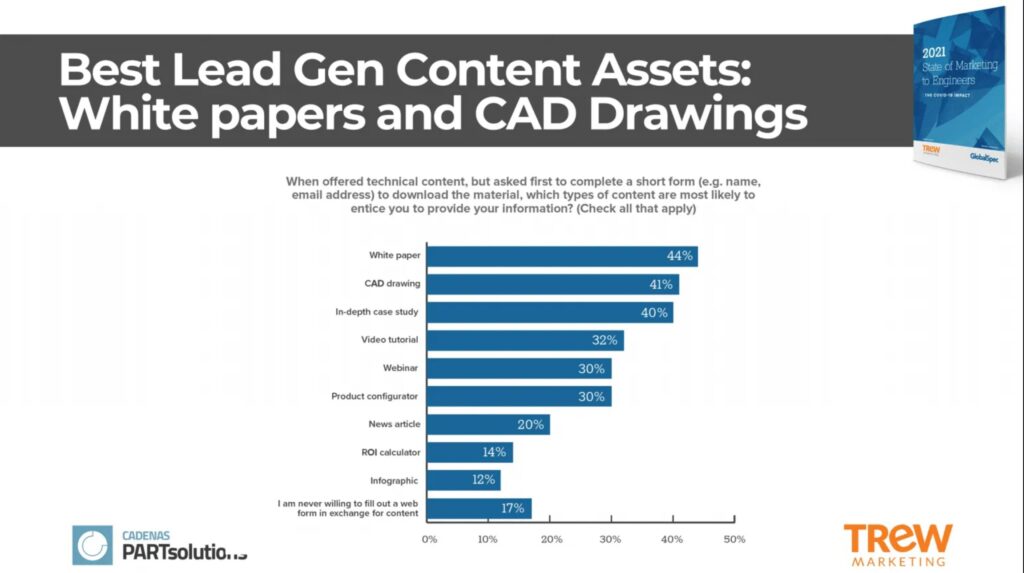
What do engineers think about content behind a form?
Wendy Covey: So, we’ve covered a broad range of types of content. And now I’d like to dig into gated industrial marketing content, or that is content behind a form, which of course, is a popular way for your website to be turned into a lead generating machine. We wanted to know when will engineers fill out a form. And if so, two which types of content are most likely to receive that valuable form complete.
So, the survey asked when offered technical content but asked first to complete a short form to download the material, which types of content are most likely to entice you to provide your information. And as you can see here, the top three most valued industrial marketing content pieces remain the same from our last year’s findings, which is white papers and CAD drawings.
And it’s funny last year, CAD drawings were on top of white papers and number two, and this year they flipped. So, you can see the two of those are always neck and neck for the top two spots.
Video tutorials were a new response that we added this past year, and it comes in 32%, just ahead of webinars and product configurators.
Engineers are least entice to provide their contact information for ROI, calculators, and infographics. And only 17% of engineers said they are never willing to fill out a form in exchange for information.
Engineers and architects are not allergic to forms
Adam Beck: Yeah. It’s your sentence structure, or your question structure is interesting to me because you said content you’re willing to fill out a form for. We’ve been told for years that engineers and architects are allergic to forms, but they’re just like the rest of us. They need content to do their jobs, and they’ll complete a form to get it. It’s an understood transaction. We do it every day.
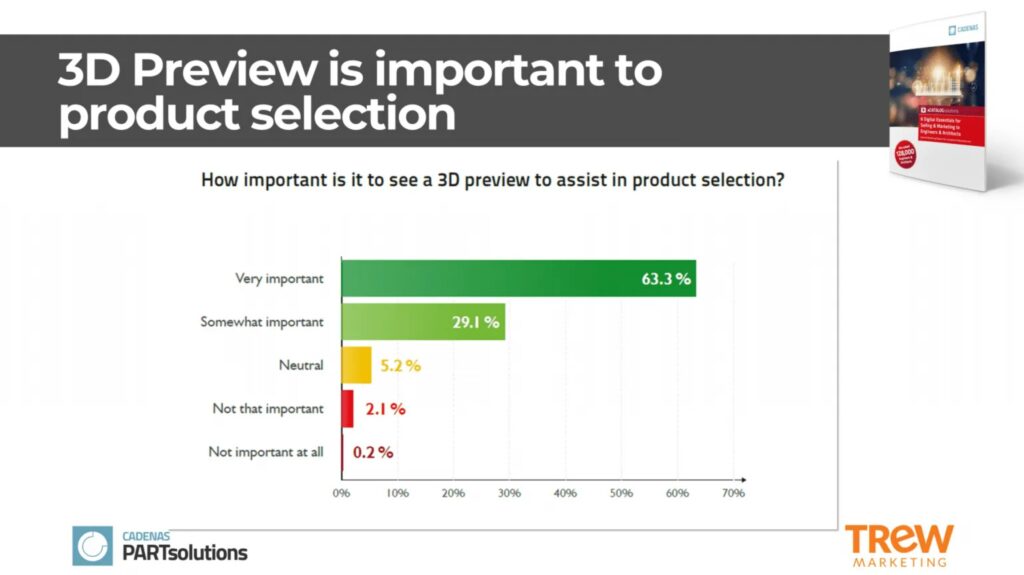
Having a 3D preview is important to engineers
Adam Beck: So, let’s actually chat about some industrial marketing content on the website.
We asked, “how important is it to see a 3D preview to assist in product selection?”
Sixty-three percent think this is very important, and 29% consider it somewhat important, making it ninety-two percent of engineers and architects who consider a 3D preview as an important factor for product selection.
Wendy Covey: Huh. So, I expected 3D to be a “nice to have,” but in thinking about some of the challenging spaces that design engineers and architects are working with, I guess it’s no wonder that this is an important piece of content.
Adam Beck: Yeah. A photo is great. A drawing is great, depending on how much detail there is. It’s really helpful to have a 3D preview, though, when the product has options or configurations. I was actually, just last week, trying to buy a lid for our septic tank out in our yard. I could find plenty of 2D single drawings or a photo of the top of it, and I was just like, come on, I want to see the other side of this thing, turn it around so I can see if it’s gonna fit.
Engineers have to go through that every day for every product they specify.

What if a supplier doesn’t offer CAD or BIM files on their website
So, let’s get to the next one.
“If a supplier does not offer CAD or BIM models online, what do you do?”
Forty-four percent redraw the part themselves, 36% find it from another supplier, and only 20% actually call or email to contact the supplier directly. This is really speaking to companies who assume people reach out. If they don’t see what they want online or what they need online. That may be true for certain groups, but it’s not universally true.
Eighty percent of the time, if they don’t see what they need, they bounce.
Wendy Covey: This is powerful data. So, by not offering a CAD or BIM model, you add friction to the buying process and risk losing the sale altogether. Wow.
Adam Beck: Yeah, exactly. Actually, if we jumped to the next one, it builds right off of that thought.

How often does a CAD or BIM download lead to a purchase
Adam Beck: So, we asked, “if you download a CAD or BIM file of a part, does the physical part ultimately get purchased?”
Eighty-two percent of respondents here said yes. When I download a digital model, I eventually buy the product.
This question is actually the genesis of the survey for us. We’ve done this for many years, and we’ve spoken with many manufacturers who told us this anecdotally, but we’d also speak with manufacturers who weren’t buying it.
They didn’t think someone downloading a thing from your website would actually lead to a sale. So we said, Let’s ask the engineers. We’ve done this survey five or six times now, and we keep getting the same result.
Wendy Covey: Wow. Eighty-two percent? Wow.
Okay. So by offering this type of file, you’ve taken the friction out of the buying process, and you have yourself a leading indicator of a sale. That’s powerful insight for sales leadership.
Adam Beck: Yes, exactly. It’s perfect for forecasting or just building pipeline, staffing, any of those things. It’s a great leading indicator of what’s coming next, and it actually leads perfectly into the next data point.
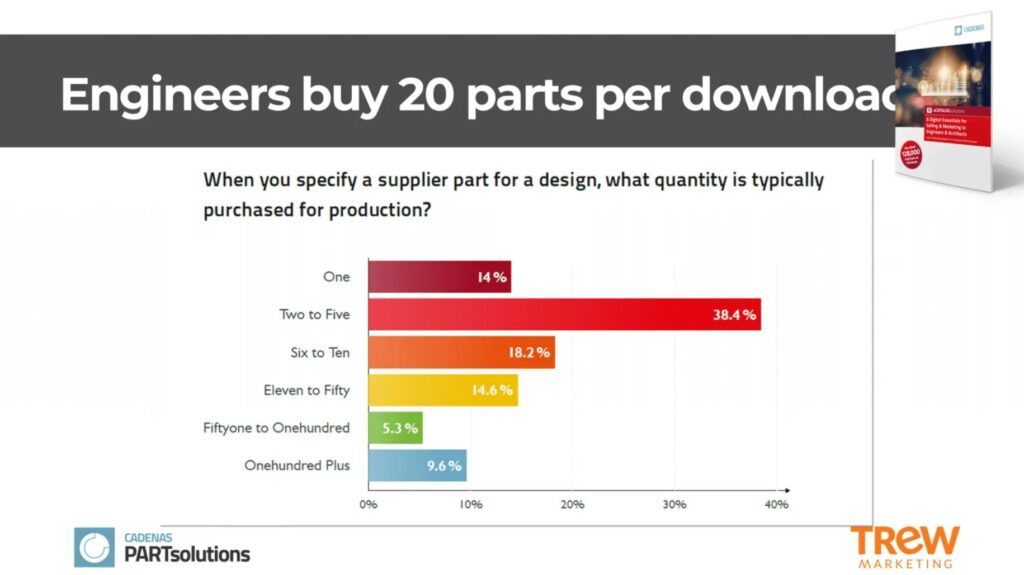
What quantity of parts are purchased after delivering industrial marketing content in the form of 3D CAD
Adam Beck: We asked, “when you specify a supplier part for a design, what quantity is typically purchased for production?”
Now, this is building on the previous question where we asked if they are buying the products they download. Now we’re asking how many. You can see it’s not just one. Thirty-eight percent purchased that two to five range, but it says last two that are very telling 5% purchase, 50 to 100 products, and 9% purchase 100 plus.
So, when you do the math on that, it averages out to 20 parts per download.
Wendy Covey: Wow. That’s more helpful data to help forecast and manage a pipeline. And Adam, imagine the number changes, though, based on the size of the company, the size of the project, and it might even be influenced by the demographics of who answered your research study?
Adam Beck: Yeah. Yeah. These are gross averages here. We have components that may cost thousands of dollars, AC drives and motors, as well as tiny electrical components, which might, may cost a few cents. But if you do some quick math and you say a company gets a hundred downloads and 82% of those convert to a sale. So, that’s 82 sales. If you multiply that by 20, that’s 1600 products sold. That is the power of providing this kind of industrial marketing content.
Wendy Covey: Wow. Boom. That’s powerful data right there.
Six Industrial Marketing Contnet Tips for Manufacturing Companies
Wendy Covey: Adam, we’ve covered a lot of ground here with our combined research findings. This was really cool. And thank you. This was all Adam’s idea to put her research studies together.
And, I’d like to now move into our six marketing tips for manufacturers.
So, starting at number one. Websites should be easy to use with a streamlined path to product information. You should offer a variety of industrial marketing content, including visual and in-depth technical information. Remove friction from the buying process by offering CAD and BIM files and printable PDF datasheets. Use high-value gated content, not salesy contact forms, to capture leads.
Track and follow up on all industrial marketing content downloads. And know that content form submits don’t equal sales readiness, so watch for buying signs. So, when we say follow up on content downloads, it doesn’t mean they’re ready to talk to sales.
- Websites should be easy to use, with a streamlined path to product information
- Offer a variety of content, including visual and in-depth technical information
- Remove friction from the buying process by offering CAD/BIM files and printable pdf datasheets
- Use high-value gated industrial marketing content, not salesy contact forms, to capture leads
- Track and follow up on content downloads
- Content form submits don’t equal sales-readiness – watch for buying signs
Adam Beck: Yes. But each of those content downloads is a valuable lead, which should be nurtured in your sales and marketing process. And that’s big. They don’t need a sales call necessarily, but nurture them and keep them alive and marching down the path.
But my overall takeaway is this customer experience is largely moved online, and manufacturers need to streamline the path and provide as much detailed product information as they can.
When they finally see engineering data as marketing content, it’s like they enter the matrix. They’ll finally be delivering what their audience needs, and their sales will reflect that.
Wendy Covey: The matrix, I love that.
My take is that all of these tips are focused on helping buyers find the information they need to make a purchase decision. And by being generous with your content and your expertise, you’re much more likely to make it to that final buying a table when they narrow down who they want to work with. Just be generous and build your industrial marketing content and put your buyer first.
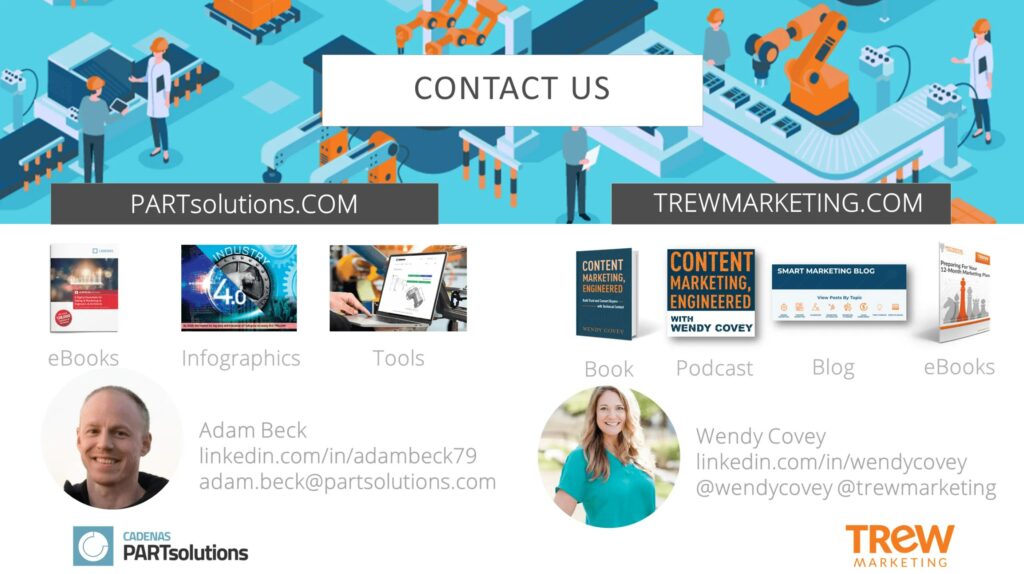
Contact Adam Beck or Wendy Covey
Adam Beck: Yeah. Again, I’m Adam Beck.
You can find us at partsolutions.com. We have eBooks for download, infographics that are wide open, no forms on those, or there are ways you can learn a little bit more about our tools. You can reach out to me directly there’s my LinkedIn address, or you can email me at [email protected].
Wendy Covey: And you can visit trewmarketing.com to learn more about my agency. And while you’re there, you can subscribe to our blog, to my podcast called Content Marketing Engineered, and we have an e-newsletter as well that is monthly. And you can also cruise our industrial marketing content assets. We have eBooks, research reports, and more, and if you’re looking for a more comprehensive guide to content marketing, I do have a book called Content Marketing Engineered, which you can find through our site or on Amazon.
And then finally, if you’re looking for a marketing partner, I’d be happy to meet with you to explore your needs. And you can hit me up on LinkedIn. I’m happy to meet with you. So, thank you all for being here today.
Thank you.
Adam Beck: Thanks, Wendy!
